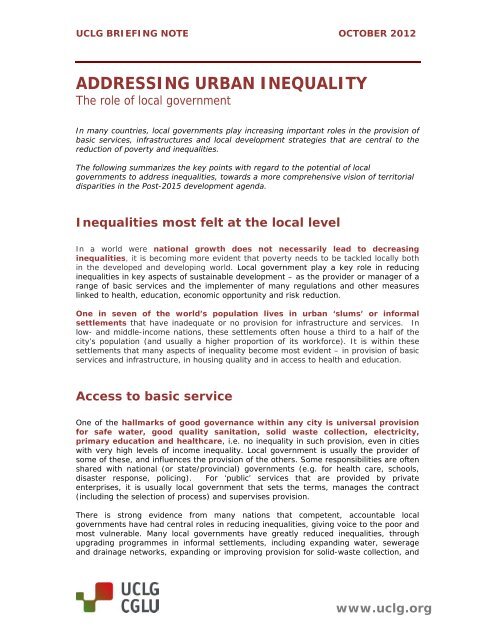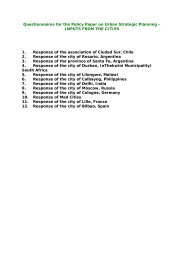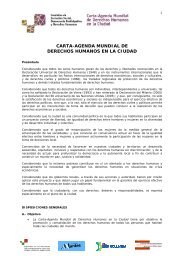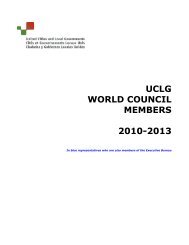ADDRESSING URBAN INEQUALITY - UCLG
ADDRESSING URBAN INEQUALITY - UCLG
ADDRESSING URBAN INEQUALITY - UCLG
Create successful ePaper yourself
Turn your PDF publications into a flip-book with our unique Google optimized e-Paper software.
<strong>UCLG</strong> BRIEFING NOTE OCTOBER 2012<br />
<strong>ADDRESSING</strong> <strong>URBAN</strong> <strong>INEQUALITY</strong><br />
The role of local government<br />
In many countries, local governments play increasing important roles in the provision of<br />
basic services, infrastructures and local development strategies that are central to the<br />
reduction of poverty and inequalities.<br />
The following summarizes the key points with regard to the potential of local<br />
governments to address inequalities, towards a more comprehensive vision of territorial<br />
disparities in the Post-2015 development agenda.<br />
Inequalities most felt at the local level<br />
In a world were national growth does not necessarily lead to decreasing<br />
inequalities, it is becoming more evident that poverty needs to be tackled locally both<br />
in the developed and developing world. Local government play a key role in reducing<br />
inequalities in key aspects of sustainable development – as the provider or manager of a<br />
range of basic services and the implementer of many regulations and other measures<br />
linked to health, education, economic opportunity and risk reduction.<br />
One in seven of the world’s population lives in urban ‘slums’ or informal<br />
settlements that have inadequate or no provision for infrastructure and services. In<br />
low- and middle-income nations, these settlements often house a third to a half of the<br />
city’s population (and usually a higher proportion of its workforce). It is within these<br />
settlements that many aspects of inequality become most evident – in provision of basic<br />
services and infrastructure, in housing quality and in access to health and education.<br />
Access to basic service<br />
One of the hallmarks of good governance within any city is universal provision<br />
for safe water, good quality sanitation, solid waste collection, electricity,<br />
primary education and healthcare, i.e. no inequality in such provision, even in cities<br />
with very high levels of income inequality. Local government is usually the provider of<br />
some of these, and influences the provision of the others. Some responsibilities are often<br />
shared with national (or state/provincial) governments (e.g. for health care, schools,<br />
disaster response, policing). For ‘public’ services that are provided by private<br />
enterprises, it is usually local government that sets the terms, manages the contract<br />
(including the selection of process) and supervises provision.<br />
There is strong evidence from many nations that competent, accountable local<br />
governments have had central roles in reducing inequalities, giving voice to the poor and<br />
most vulnerable. Many local governments have greatly reduced inequalities, through<br />
upgrading programmes in informal settlements, including expanding water, sewerage<br />
and drainage networks, expanding or improving provision for solid-waste collection, and<br />
www.uclg.org
influencing the prices and availabilities of housing through provision of land. In Africa<br />
and Asia, sub-national governments in many countries implemented free basic school<br />
programmes, school feeding and free transportation programmes.<br />
The response to MDGs 4, 5 and 6 has been monumental, in part due to the role played<br />
by sub-national governments in providing and managing public health facilities in their<br />
respective jurisdictions. Sub-national governments were the focus for mobilizing<br />
community groups, and resources, and for using local systems for campaigns on<br />
immunization, maternal care, HIV-AIDs, and distribution of mosquito nets.<br />
Social inclusion and participatory democracy<br />
Women’s empowerment advanced when sub-national institutions took the lead<br />
in implementing programmes. Gender analysis and application featured in local<br />
representation, data-collection and decision-making, development prioritization,<br />
resource allocation and reporting. In countries such as Armenia, Chile, Rwanda,<br />
Tanzania, Samoa and Bangladesh, this has contributed to significant MDG 3 gains.<br />
Many city governments around the world have implemented innovative forms of<br />
participatory democracy to address the inequalities in voice and influence faced<br />
by low-income groups, minorities or groups facing discrimination (for instance<br />
women and youth). This can be seen in participatory budgeting or planning, local<br />
assemblies or “dialogue days” between local elected officers and communities, quotas<br />
reserved to ensure the representation of women, traditional authorities or certain<br />
minorities and the use of social media and new technologies to encourage participation,<br />
as well as different kinds of referenda or consultations.<br />
Many city governments now work with the organizations and federations of ‘slum’/shack<br />
dwellers to directly address a range of inequalities that include housing tenure,<br />
infrastructure, services, rule of law and participation.<br />
Limited data on growing challenges<br />
One key reason why inequality has been neglected until now is the lack of data<br />
on most of its aspects. Most national governments and international agencies rely on<br />
national sample surveys to provide data on health and service provision. But collecting<br />
data in national sample surveys means very limited data available on<br />
inequalities within sub-national territorial divisions. And the data that<br />
governments and international agencies choose to collect obviously influences what they<br />
choose to focus on.<br />
The need to increase the capacity of urban governments to address these inequalities<br />
and to be accountable to their populations is particularly urgent in sub-Saharan Africa<br />
where the deficits in infrastructure and service provision are largest – as well as in many<br />
Asian nations where rapid urbanization is outstripping the ability of local government to<br />
manage growth. UN projections suggest that almost all the increases in the world’s<br />
population from 2010 to 2030 will be in urban centers in low- and middle-income nations<br />
(United Nations 2012). How well local governments serve these 1.4 billion new urban<br />
dwellers (and how well higher levels of government support them to do so) will have<br />
very large implications for whether inequality is reduced and sustainable development<br />
achieved.<br />
2 Contributions to the High Level Panel, London 31 October – 2 November 2012







